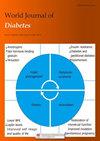Evaluating new biomarkers for diabetic nephropathy: Role of α2-macroglobulin, podocalyxin, α-L-fucosidase, retinol-binding protein-4, and cystatin C
IF 4.2
3区 医学
Q1 ENDOCRINOLOGY & METABOLISM
引用次数: 0
Abstract
BACKGROUND The intricate relationship between type 2 diabetes mellitus (T2DM) and diabetic nephropathy (DN) presents a challenge in understanding the significance of various biomarkers in diagnosis. AIM To elucidate the roles and diagnostic values of α2-macroglobulin (α2-MG), podocalyxin (PCX), α-L-fucosidase (AFU), retinol-binding protein-4 (RBP-4), and cystatin C (CysC) in DN. METHODS From December 2018 to December 2020, 203 T2DM patients were enrolled in the study. Of these, 115 were diagnosed with DN (115 patients), while the remaining 88 patients were classified as non-DN. The urinary levels of α2-MG, PCX, and AFU and the serum concentrations RBP-4 and CysC were measured in conjunction with other relevant clinical indicators to evaluate their potential correlations and diagnostic utility. RESULTS After adjustments for age and gender, significant positive correlations were observed between the biomarkers CysC, RBP-4, α2-MG/urinary creatinine (UCr), PCX/UCr, and AFU/UCr, and clinical indicators such as urinary albumin-to-creatinine ratio (UACR), serum creatinine, urea, 24-h total urine protein, and neutrophil-to-lymphocyte ratio (NLR). Conversely, these biomarkers exhibited negative correlations with the estimated glomerular filtration rate (P < 0.05). Receiver operating characteristic (ROC) curve analysis further demonstrated the diagnostic performance of these biomarkers, with UACR showcasing the highest area under the ROC curve (AUCROC) at 0.97. CONCLUSION This study underscores the diagnostic significance of α2-MG, PCX, and AFU in the development of DN. The biomarkers RBP-4, CysC, PCX, AFU, and α2-MG provide promising diagnostic insights, while UACR is the most potent diagnostic biomarker in assessing DN.评估糖尿病肾病的新生物标记物:α2-巨球蛋白、荚膜黏蛋白、α-L-岩藻糖苷酶、视黄醇结合蛋白-4 和胱抑素 C 的作用
背景 2 型糖尿病(T2DM)与糖尿病肾病(DN)之间的关系错综复杂,这给了解各种生物标志物在诊断中的意义带来了挑战。目的 阐明α2-巨球蛋白(α2-MG)、荚膜黏蛋白(PCX)、α-L-岩藻糖苷酶(AFU)、视黄醇结合蛋白-4(RBP-4)和胱抑素 C(CysC)在 DN 中的作用和诊断价值。方法 从 2018 年 12 月至 2020 年 12 月,203 名 T2DM 患者被纳入研究。其中,115 名患者被诊断为 DN(115 例患者),其余 88 例患者被归类为非 DN 患者。研究人员结合其他相关临床指标测定了尿液中的α2-MG、PCX和AFU水平以及血清中的RBP-4和CysC浓度,以评估其潜在的相关性和诊断效用。结果 对年龄和性别进行调整后,发现 CysC、RBP-4、α2-MG/尿肌酐(UCr)、PCX/UCr 和 AFU/UCr 等生物标志物与尿白蛋白与肌酐比值(UACR)、血清肌酐、尿素、24 小时尿蛋白总量和中性粒细胞与淋巴细胞比值(NLR)等临床指标之间存在显著的正相关。相反,这些生物标志物与估计肾小球滤过率呈负相关(P < 0.05)。接收者操作特征(ROC)曲线分析进一步证明了这些生物标志物的诊断性能,其中 UACR 的 ROC 曲线下面积(AUCROC)最高,为 0.97。结论 本研究强调了α2-MG、PCX 和 AFU 在 DN 发病过程中的诊断意义。生物标记物 RBP-4、CysC、PCX、AFU 和 α2-MG 提供了有前景的诊断见解,而 UACR 是评估 DN 最有效的诊断生物标记物。
本文章由计算机程序翻译,如有差异,请以英文原文为准。
求助全文
约1分钟内获得全文
求助全文
来源期刊

World Journal of Diabetes
ENDOCRINOLOGY & METABOLISM-
自引率
2.40%
发文量
909
期刊介绍:
The WJD is a high-quality, peer reviewed, open-access journal. The primary task of WJD is to rapidly publish high-quality original articles, reviews, editorials, and case reports in the field of diabetes. In order to promote productive academic communication, the peer review process for the WJD is transparent; to this end, all published manuscripts are accompanied by the anonymized reviewers’ comments as well as the authors’ responses. The primary aims of the WJD are to improve diagnostic, therapeutic and preventive modalities and the skills of clinicians and to guide clinical practice in diabetes. Scope: Diabetes Complications, Experimental Diabetes Mellitus, Type 1 Diabetes Mellitus, Type 2 Diabetes Mellitus, Diabetes, Gestational, Diabetic Angiopathies, Diabetic Cardiomyopathies, Diabetic Coma, Diabetic Ketoacidosis, Diabetic Nephropathies, Diabetic Neuropathies, Donohue Syndrome, Fetal Macrosomia, and Prediabetic State.
 求助内容:
求助内容: 应助结果提醒方式:
应助结果提醒方式:


